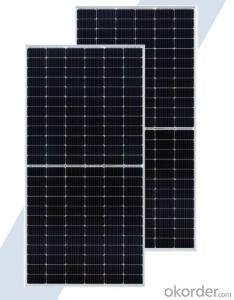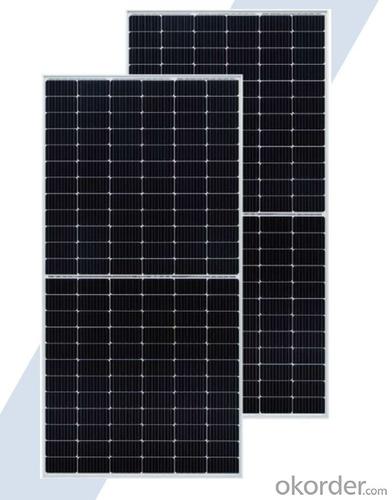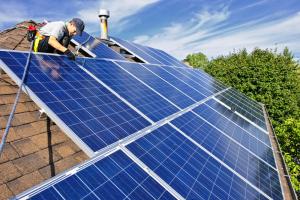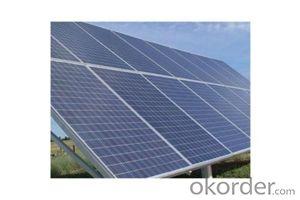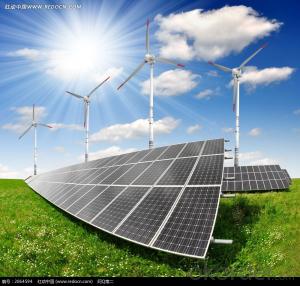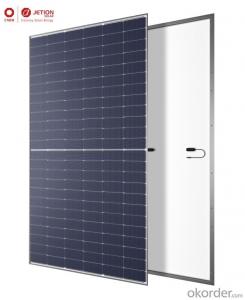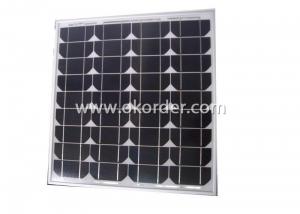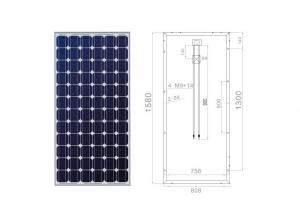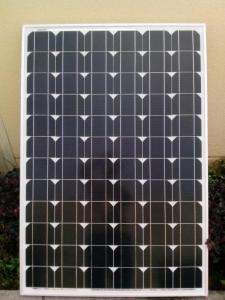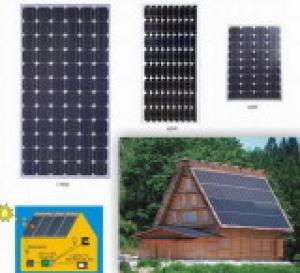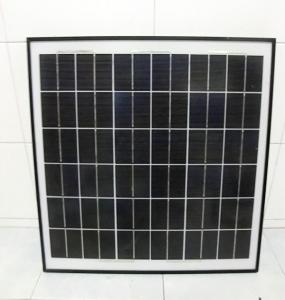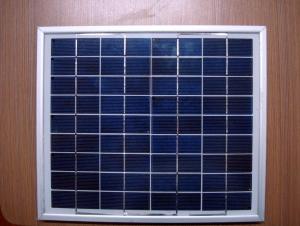Buying Versus Leasing Solar Panels:18-MH72 N Type Topcon SMBB Half Cell 555-575W
- Loading Port:
- China main port
- Payment Terms:
- TT or LC
- Min Order Qty:
- 31 pc
- Supply Capability:
- 620 pc/month
OKorder Service Pledge
OKorder Financial Service
You Might Also Like
Specification
NAME: 18-MH72 N type Topcon SMBB Half Cell 555-575W
Features:
Half-cut cell technology (lower internal current, lower power loss);
Excellent weak light performance (More power output in weak light condition);
Lower the risk of hot spot (Special design with lower hot spot temperature);
Lower LCOE (Higher Power Generation, Lower LCOE).
Warranty:
15 years ----Product quality and process guarantee
25 years ----Linear power guarantee
2% First year power degradation
0.55% Annual degradation over 25 years
Qualification:
IEC 61215; IEC 61730; ISO 9001; ISO 14001; ISO 45001
Electrical Characteristics
Module Type | 18- MH72-555 | 18- MH72-555 | 18- MH72-565 | 18- MH72-570 | 18- MH72-575 | |
Maximum Power (Pmax/W) |
555 |
560 |
565 |
570 |
575 | |
Open Circuit Voltage (Voc/V) |
49.68 |
49.77 |
49.86 |
49.94 |
50.02 | |
Short Circuit Current (Isc/A) |
14.12 |
14,19 |
14.26 |
14.32 |
14.4 | |
Voltage at Maximum Power (Vmpp/V) |
42.1 |
42.25 |
42.4 |
42.55 |
42.7 | |
Current at Maximum (Impp/A) |
13.18 |
13.25 |
13.33 |
13.4 |
13.47 | |
Module Efficiency (η%) |
21.5 |
21.7 |
21.9 |
22.1 |
22.3 | |
Temperature Coefficient of Pmax -0.35%/℃ Temperature Coefficient of Voc -0.27%/℃ Temperature Coefficient of Isc +0.05%/℃ Working Temperature -40℃-80℃ Normal Module Operating Temperature (NMOT) 45±2℃ | ||||||
Mechanical Characteristics | ||||||
Cell type | Monocrystalline silicon 182mm | |||||
Number of cells | 144(6*24) | |||||
Dimensions | 2279*1134*35mm | |||||
Weight | 27.5kg | |||||
Cables | 4mm², 300mm OR customized length | |||||
Junction Box | IP68 Rated | |||||
Maximum System Voltage | 1500VDC | |||||
Glass | 3.2mm Tempered glass | |||||
Frame | Anodized aluminum ally | |||||
Connectors | MC4 compatibility | |||||
Packing | 31pcs/Pallet | |||||
- Q: Are solar panels safe?
- Yes, solar panels are safe. They are designed and installed to meet strict safety standards. They do not produce any emissions, and the risks associated with solar panels are extremely low. However, it is important to ensure proper installation and maintenance to maximize safety.
- Q: The voltage and power problems of solar panels
- 3, charge 12V battery when the power is really small, if it is a normal controller, then the equivalent of 18V voltage in the charge, probably 18 x (240 / 30.2) = 143w solar panels.
- Q: The first panel is located in New England, the second is placed in the Sahara desert, the third is on the Earth side of the moon, and the last is on the far side of the moon. Which panel would absorb the most sunlight over a year's time and why ? All the panels are place in optimal places where they would get the most light available.
- Best to worst- ) The Earth side of the Moon 2) Sahara Desert 3) New England 4) Far side of the Moon
- Q: In terms of efficiency and cost, what is the best solar panel. I am limited in the number of panels I can put up (probably 6-8) so they must be efficient, but cost is important also.What about these panels that can collect a wider range of light frequency?
- You have to decide which is more important to you, cost or efficiency. The most efficient solar panels that are commercially available cost more than twice as much per square foot than the cheapest ones. Ultimately, I believe that the cost per watt was actually better on the cheaper, least efficient panels, but then you need a lot of square footage in order to generate any substantial power. So it comes down to what you have more of, space or money. The new panels that collect a wider range of light are not currently available commercially, and when they are I am sure that they will be expensive. I have read the research but have not heard of anyone mass producing them yet.
- Q: How does Solar Panel make Electricity ?
- when sunlight hits a solar panel the photons from the light hit a layer in panel that converts it into electrons through conduction, thus making electricity
- Q: How do solar panels affect the aesthetics of a building?
- Solar panels can have both positive and negative effects on the aesthetics of a building. On one hand, well-designed and integrated solar panels can enhance the visual appeal of a structure by adding a sleek and modern touch. They can be seamlessly incorporated into the architecture, becoming an attractive feature. On the other hand, if poorly installed or placed without careful consideration, solar panels can disrupt the overall design or appear as an eyesore. Therefore, the impact of solar panels on a building's aesthetics largely depends on the design, placement, and integration of the panels into the existing structure.
- Q: How do solar panels affect the resale value of a home?
- Solar panels can have a positive impact on the resale value of a home. Studies have shown that homes equipped with solar panels tend to sell faster and at a higher price compared to those without. This is mainly because solar panels offer potential buyers the benefit of reduced energy costs and a more sustainable lifestyle. Additionally, the presence of solar panels can enhance the overall appeal and desirability of a property in today's environmentally conscious market.
- Q: The ancients used skylights for light in lieu of electricity. Light was used for drying, even cooking foods and drying clothes. Solar clocks/sun dials were once popular but now we have battery operated clocks. Where have we tapped into any of these resources since the outdated solar clothes drier nicknamed the 'clothes line'?
- Have you seen the industrial solar power tower they built in Spain? It has a very large collection of mirrors which direct sunlight toward a single point at the top of a large tower. There a boiler turbine generates a lot of electricity! It is a genius concept that could easily be installed in North American deserts.
- Q: I want to also know if the 0 watt rating on the solar panel is 0 watts per day or is it constantly adding 0 watts? Is there a time which the 0 watts is being added like 0 watts per second or 0 watts per minute and so on?
- a 0w solar panel means at peak efficiency ( high noon, panel pointed flat at the sun, hitting it at 90 degrees), you will get 0 watts (at any given second). Watts = volts x amps a 2volt battery needs an incoming current of at least 3 volts to charge it; 3.5 volts is better. so if the output VOLTAGE of the panel is less than 3 volts it wont do anything. Even if it is, 0 / 3.5 = .74 amp.( three quarters). It will take forever and a day to charge a deeply discharged deep cycle battery.......... consider that a small 0v battery charger is putting out 3-5 amps ( or 3 x 0 =330 Watts) and the alternator on a car is putting out 20 to 50 amps at 4 volts ( 280 to 730 Watts).
- Q: Dear Friends, I am very much worried about Global warming, So to contribute something for reducing Global Warming I have decided to use Solar Panels. Can anybody tell me what is the price of these Solar Panels and why people are not using them when they are environment friendly. What are the Pros and Cons of these Solar Panels?
- In the US and western Europe, the average cost to install a solar system.....panels, wire, battery bank inverters and all of that is $5 ( five) US a watt. ( One panel, 2 x 3 feet putting out 75 Watts costs $700-800 US ) Mos American homes use about 000 kilo Watt hours of electricity a month.. oking, heating, cooling, refrigeration, water lights and all that. that is 2,000 kilowatts a year. A solar panel system would therefore cost $60,000 US to install. That is WAY beyond almost everyone's means, which is why the US and Europe is not covered in solar panels. There is also the amount of sunlight per day and the height of the sun in the sky. There is a formula to figure out how much usable sunlight a day you get; the further north the less......and that number averages out to about 5 hours a day year round. So back to the 000 kW a month.......30 + kWh a day.......in 5 hours a day you have to generate 6,000 watts .... divide by 75 watts a panel = 35 panels x 75.00 per = 25,000 $ US plus wiring, batteries and all that........
Send your message to us
Buying Versus Leasing Solar Panels:18-MH72 N Type Topcon SMBB Half Cell 555-575W
- Loading Port:
- China main port
- Payment Terms:
- TT or LC
- Min Order Qty:
- 31 pc
- Supply Capability:
- 620 pc/month
OKorder Service Pledge
OKorder Financial Service
Similar products
Hot products
Hot Searches
Related keywords
